The latest edition to the Synology Plus line of NAS devices is the Synology DiskStation DS1019+. Typically the name of the device is indicative of how many bays it has plus the model year, in this case 10 bays in 2019-model year. The DS1019+ is a 5 bay NAS but is expandable to 10 bays. The DS1019+ is aimed at SOHO or home users that need some extra performance.
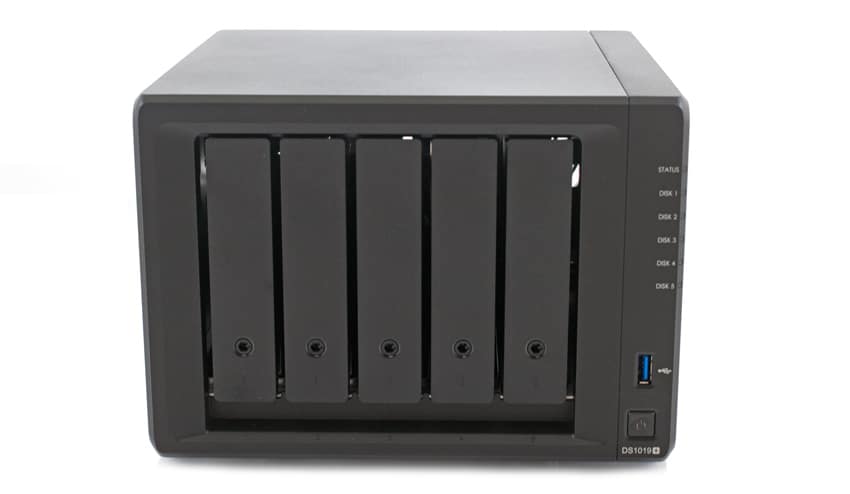
The DS1019+ comes with an Intel quad-core processor and up to 8GB of RAM. Synology states that this allows the NAS to deliver up to 225MB/s read and write even with data encryption on (the NAS supports AES-NI encryption). This makes the DS1019+ an ideal choice for real-time 4K video transcoding, the NAS supports this and comes with built-in applications for 4K video transcoding. For even faster performance, the DS1019+ has dual M.2 NVMe SSD slots to allow for SSD cache while not taking up some of the main bays.
As with all Synology NAS devices, the DS1019+ is powered by the company’s DSM OS. DSM is still one of the user friendliest and intuitive NAS OS’s on the market. While DSM has a plethora of applications (referred to as packages) there are a few that are specifically beneficial to use with the DS1019+. Theses include Video Station and Audio Station for those that wish to leverage the 2 channels of H.264/H.265 4K videos. And there are several backup applications for SOHO that need to backup important data and applications.
Synology DiskStation DS1019+ Specifications
| CPU | Intel Celeron J3455 quad-core 1.5GHz, burst up to 2.3GHz |
| Memory | 4 GB DDR3L-1866 Non-ECC SO-DIMM (expandable up to 8 GB) |
| Hot Swappable Bays | 5 (expandable to 10 bays with the DX517) |
| Compatible drive types | 5 x 3.5” or 2.5” SATA HDD/SSD 2 x M.2 NVMe 2280 SSD |
| External ports | 2 x USB 3.0 port 1 x eSATA port 2 x Gigabit (RJ-45) |
| Networking protocol | SMB AFP NFS FTP WebDAV CalDAV iSCSI Telnet SSH SNMP VPN (PPTP, OpenVPN, L2TP) |
| File System | |
| Internal | Btrfs ext4 |
| External | Btrfs ext4 ext3 FAT NTFS HFS+ exFAT |
| Physical | |
| Size (HxWxD) | 166 x 230 x 223 mm |
| Weight | 2.54 kg |
| Power | |
| System fan | 2 (92 x 92 x 25 mm) |
| AC input power voltage | 100V to 240V AC |
| Power frequency | 50/60Hz, single phase |
| Operating temperature | 0°C to 40°C (32°F to 104°F) |
| Storage temperature | -20°C to 60°C (-5°F to 140°F) |
| Relative humidity | 5% to 95% RH |
| Maximum operating altitude | 5,000 m (16,400 ft) |
| Warranty | 3-year |
Design and Build
The Synology DiskStation 1019+ has a similar overall design to the other NAS devices released by the company. The device is small enough to fit on a desktop and has a matte black, plastic finish. Across the front are the five, hot-swappable drive bays that fit either 3.5” or 2.5” drives. On the right side is the power button, the LED indicator lights and a USB 3.0 port.
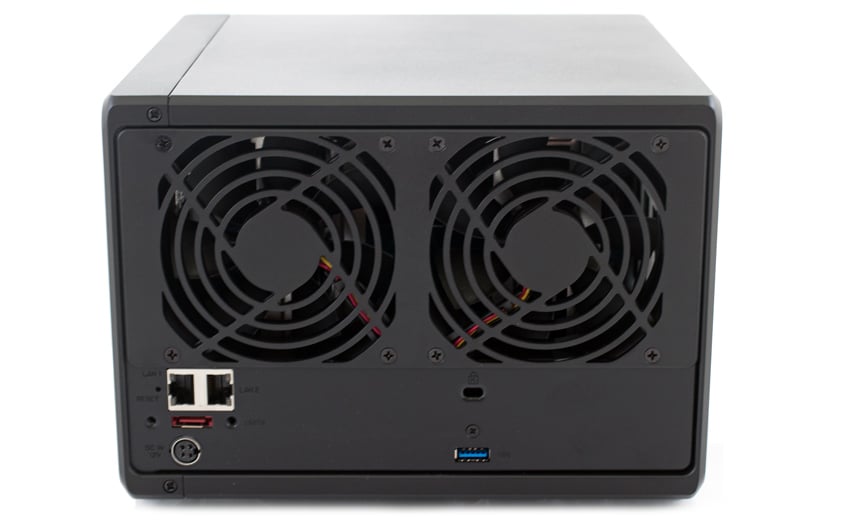
Flipping it over to the rear we see the two fans that take up the top two-thirds of the device. On the left are the two network ports, a reset button an eSATA port, and the power port. The right side has a Kensington Security Slot and another USB 3.0 port.
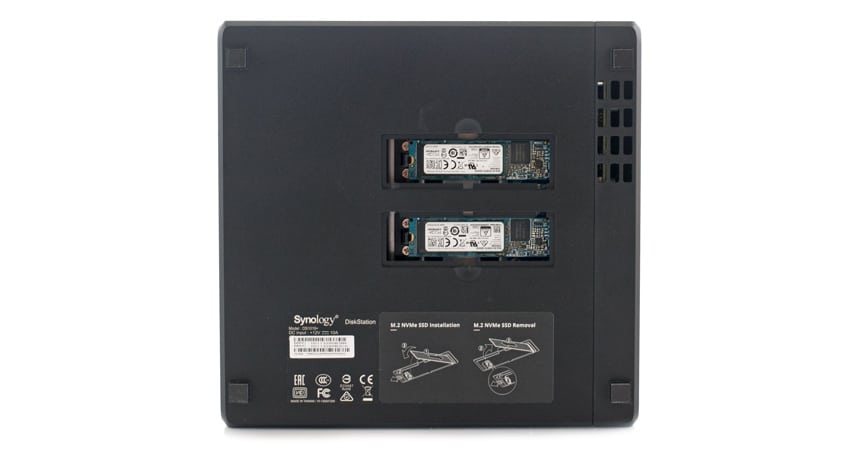
On the bottom of the device are the two M.2 NVMe slots.
SSD Cache
In the past we have covered DSM in quite some depth. As the NAS devices change and incorporate new technology (such as M.2 drive slots), the OS updates to reflect this as well as continuing to support older models from several years back.
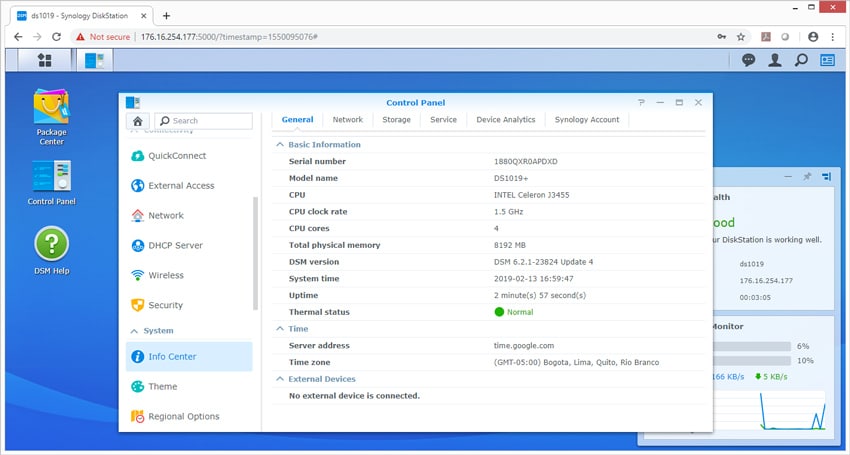
Something unique to the DS1019+ is the M.2 drive slots for SSD cache. While SSD cache is a feature that has been supported for some time, this is new as it allows for SSD cache to speed up workloads without taking up drive bays. The SSD cache screen gives users a quick run down on information such as where the cache is mounted, its mode type, RAID type, the ability to repair or remove it, the cache usage, read hit rate, and the ability to drill down into the SSD devices.
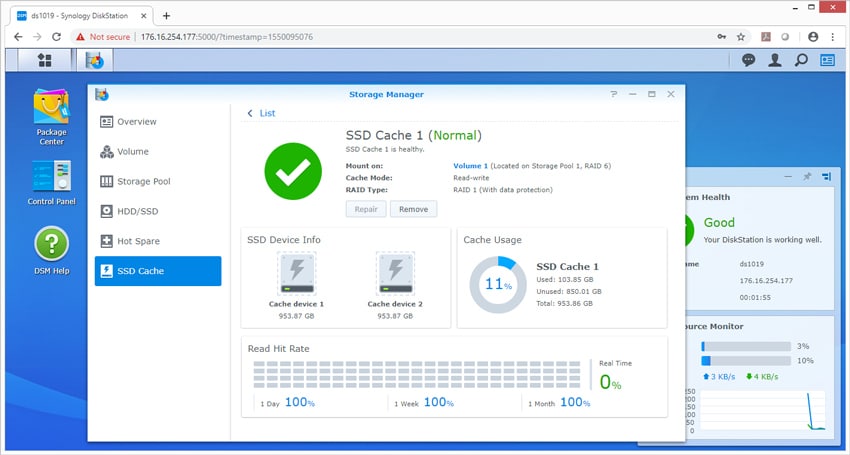
Enterprise Synthetic Workload Analysis
Our enterprise shared storage and hard drive benchmark process preconditions each drive into steady-state with the same workload the device will be tested with under a heavy load of 16 threads with an outstanding queue of 16 per thread, and then tested in set intervals in multiple thread/queue depth profiles to show performance under light and heavy usage. Since hard drives reach their rated performance level very quickly, we only graph out the main sections of each test.
Preconditioning and Primary Steady-State Tests:
- Throughput (Read+Write IOPS Aggregate)
- Average Latency (Read+Write Latency Averaged Together)
- Max Latency (Peak Read or Write Latency)
- Latency Standard Deviation (Read+Write Standard Deviation Averaged Together)
Our Enterprise Synthetic Workload Analysis includes four profiles based on real-world tasks. These profiles have been developed to make it easier to compare to our past benchmarks as well as widely-published values such as max 4k read and write speed and 8k 70/30, which is commonly used for enterprise drives.
- 4K
- 100% Read or 100% Write
- 100% 4K
- 8K 70/30
- 70% Read, 30% Write
- 100% 8K
- 8K (Sequential)
- 100% Read or 100% Write
- 100% 8K
- 128K (Sequential)
- 100% Read or 100% Write
- 100% 128K
For our testing we configured the Synology DiskStation in RAID6 in both iSCSI and CIFS. We ran each test with the SSD cache off and on. For HDD we used Toshiba N300 NAS 8TB and for the SSD cache we used two Toshiba XG5 NVMe 1TB. This is not a comparison of the SSD cache on or off, the SSD cache will provide better performance. This reflects what to expect if users choice to leverage it or not.
In the first of our enterprise workloads, we measured a long sample of random 4K performance with 100% write and 100% read activity. Looking at IOPS the DS1019+ had performance of 1,545 IOPS write and 69 IOPS read for CIFS and 2,493 IOPS write and 1,382 IOPS read in iSCSI. With SSD cache on those numbers jumped to 24,299 IOPS write and 10,474 IOPS read in CIFS and 25,767 IOPS write and 32,774 IOPS read in iSCSI.
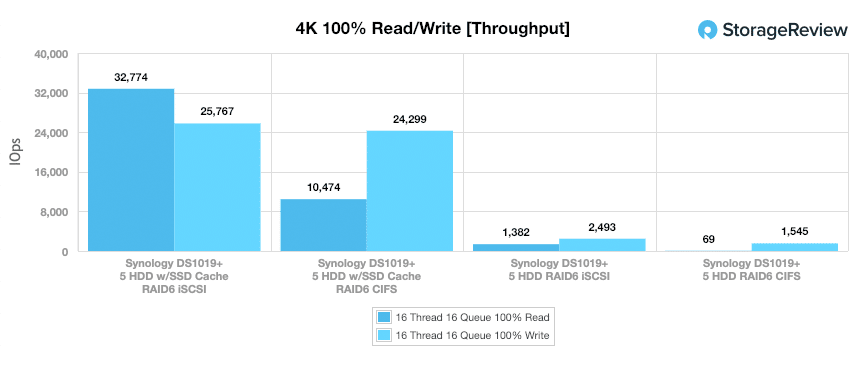
With 4K average latency the NAS hit 165.6ms write and 3,681.1ms read in CIFS and 102.7ms write and 185.2ms read in iSCSI. With SSD cache on the latency fell to 10.5ms write and 24.4ms read in CIFS and 9.9ms write and 7.8ms read in iSCSI.
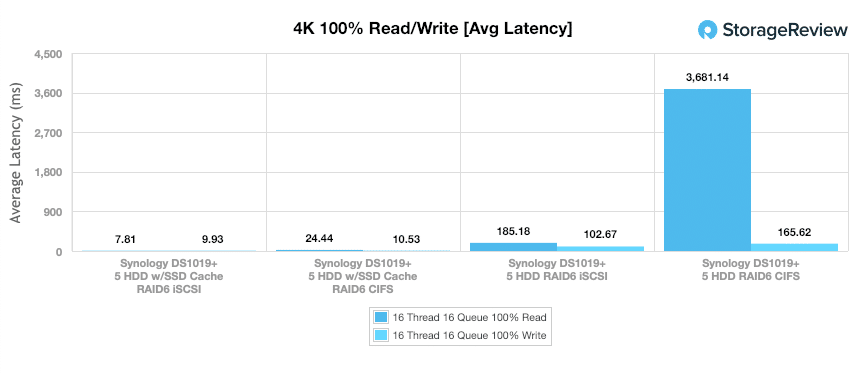
Switching over to 4K max latency the DS1019+ had 697.7ms write and 16,835ms read in CIFS and 647.8ms write and 967.5ms read in iSCSI. With the SSD cache on the latency again dropped significantly to 59.6ms write and 89.5ms read for CIFS and 190.3ms write and 155.8ms read in iSCSI.
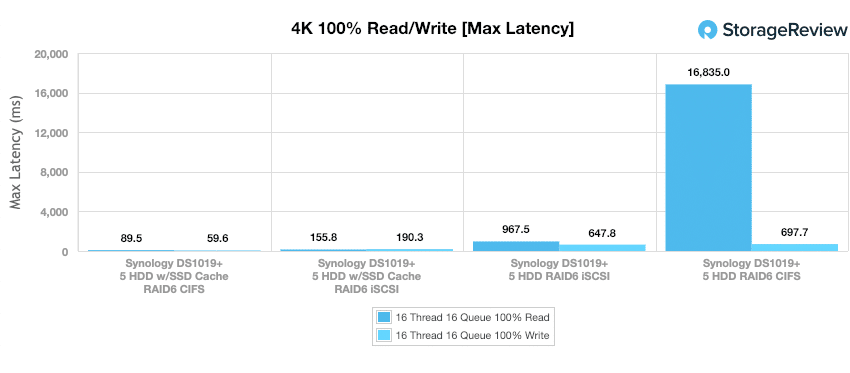
For 4K standard deviation we saw 122.4ms write and 2,775.4ms read in CIFS and 74.6ms write and 116.4ms read in iSCSI. With SSD cache enable the standard deviation was 7.7ms write and 15.3ms read in CIFS and 8.1ms write and 5.9ms read in iSCSI.
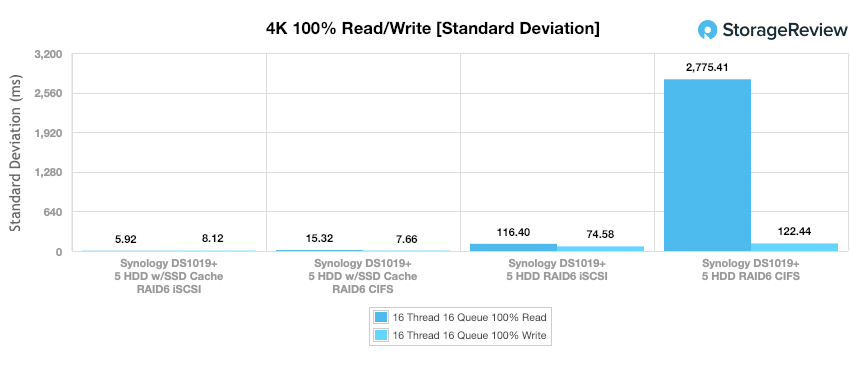
Our next benchmark measures 100% 8K sequential throughput with a 16T16Q load in 100% read and 100% write operations. Here, the DS1019+ was able to hit 26,499 IOPS write and 27,329 IOPS read in CIFS and 26,960 IOPS write and 28,220 IOPS read in iSCSI. Here with the SSD cache enable we only saw a mild improvement with 26,964 IOPS write and 28,220 IOPS read for CIFS and 27,629 IOPS write and 28,526 IOPS read in iSCSI.
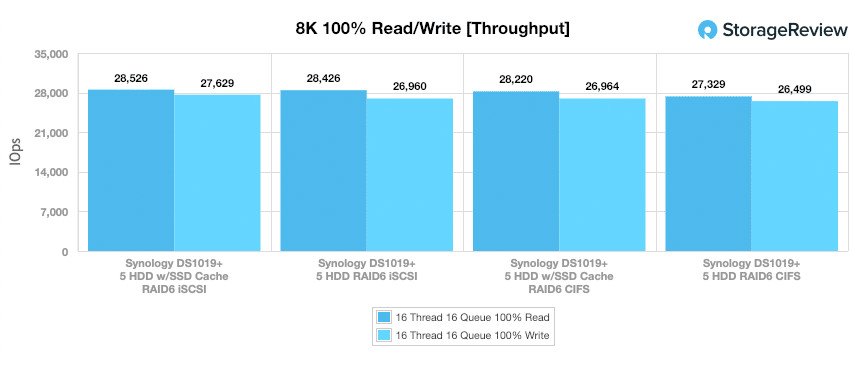
Compared to the fixed 16 thread, 16 queue max workload we performed in the 100% 4K write test, our mixed workload profiles scale the performance across a wide range of thread/queue combinations. In these tests, we span workload intensity from 2 threads and 2 queue up to 16 threads and 16 queue. In throughput, CIFS double the performance in our SSD-cache configuration compared to iSCSI, posting a range of 10,232 IOPS through 10,452 IOPS. In our HDD configuration, iSCSI had the best performance with 455 IOPS to 1,656 IOPS.
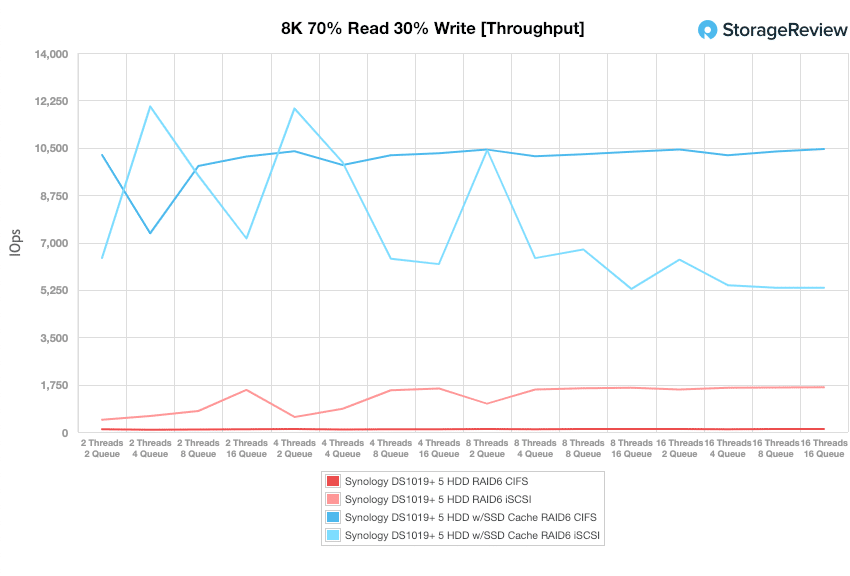
In average latency, CIFS connectivity showed the best performance in our SSD configuration (3.12ms to 12.24ms), while iSCSI was the best in our HDD set up, posting 8.78ms to 154.43ms.
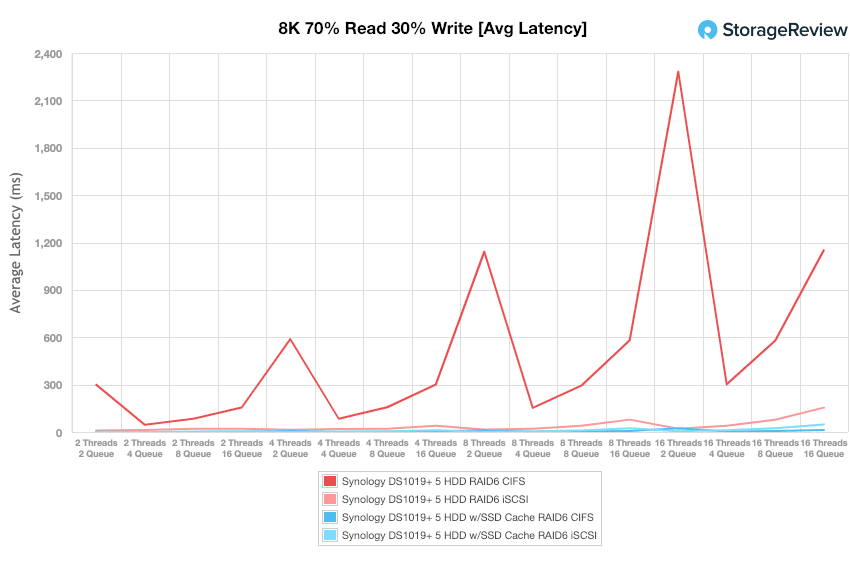
For maximum latency, iSCSI showed 84.5ms through 104.45ms and 1856.24ms through 4,395.9ms in our CIFS SSD and HDD configurations, respectively.
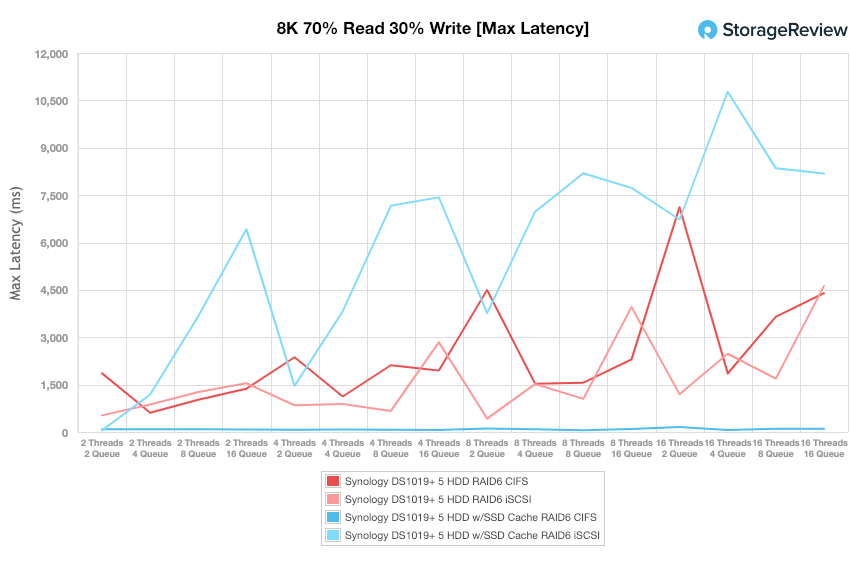
Looking at standard deviation, the DS1019+ SSD CIFS configuration recorded 2.31ms to 8.59ms, while the iSCSI HDD configuration showed a range of 18.88ms to 231.11ms.
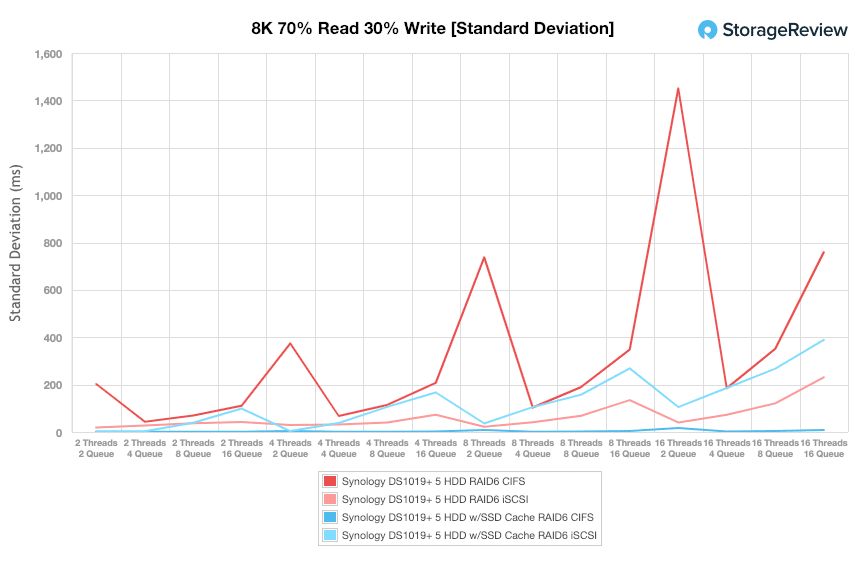
The last Enterprise Synthetic Workload benchmark is our 128K test, which is a large-block sequential test that shows the highest sequential transfer speed for a device. In this workload scenario, the DS1019+ had 226MB/s write and 230MB/s read in CIFS and 228.7MB/s write and 231.2MB/s read in iSCSI. With the SSD cache enable performance actually dropped slightly to 225.6MB/s write in CIFS and 226.8MB/s write in iSCSI. The read scores improved with SSD cache enabled to 231.4MB/s in CIFS and 231.5MB/s in iSCSI.
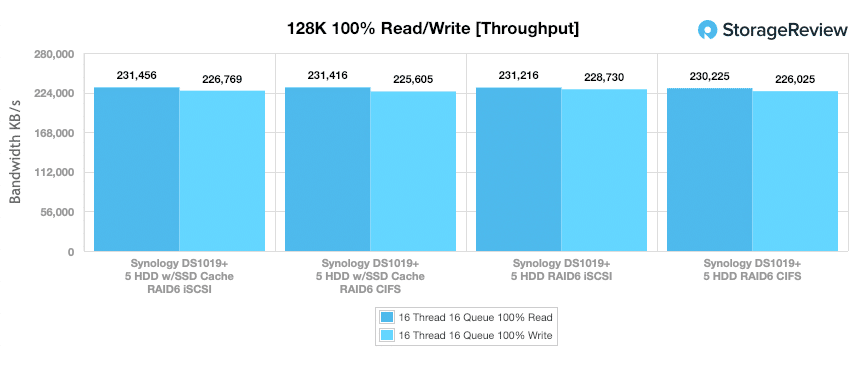
Conclusion
The Synology DiskStation DS1019+ is the newest edition to the company’s more performant Plus line. This 5-bay NAS is aimed at SOHO and home users that need a bit more of a performance kick. In fact, it is ideal for those that work with or need real-time 4K video transcoding. The hardware combined with built-in applications make this an ideal solution for 4K transcoding. The NAS leverages Synology’s award winning DiskStation Manager Operating System and is expandable to 10 bays through the DX517 expansion unit.
For performance we looked at straight HDD performance as well as the performance when enabling the SSD cache feature leveraging two NVMe M.2 drives. For the most part the NAS showed much stronger iSCSI performance with highlights including 2,493 IOPS write and 1,382 IOPS read in 4K with average latencies of 102.7ms write and 185.2ms read. In 8K 100% the NAS hit 26,960 IOPS write and 28,220 IOPS read in iSCSI. And our large block 128K saw iSCSI performance of 228.7MB/s write and 231.2MB/s read.
Enabling the SSD cache saw a performance improvement in most tests, making the most dramatic difference in CIFS configuration. For example, we saw IOPS increase from 69 to 10,474 in 4k while average latency dropped from 3,681.1ms read to 24.4ms read. However, there were a few cases where performance dropped slightly with the SSD cache enable such as 8K iSCSI and in large block 128K the read scores improved while the write scores dropped some.
The Synology DS1019+ is a small NAS that can bring the performance for small and home office, especially those that deal with video transcoding. The NVMe M.2 SSD cache on the bottom can bring certain workloads to much higher performance and lower latency.




 Amazon
Amazon